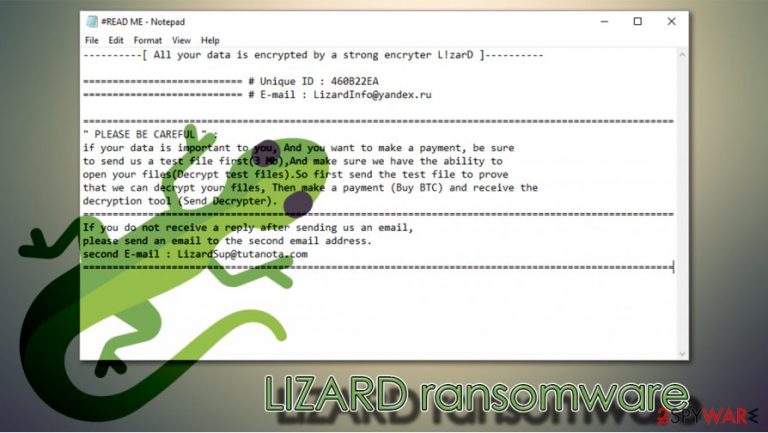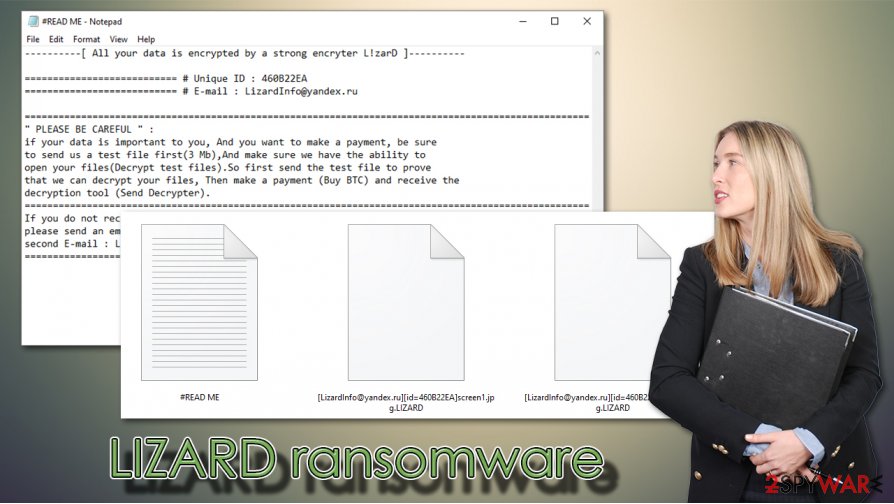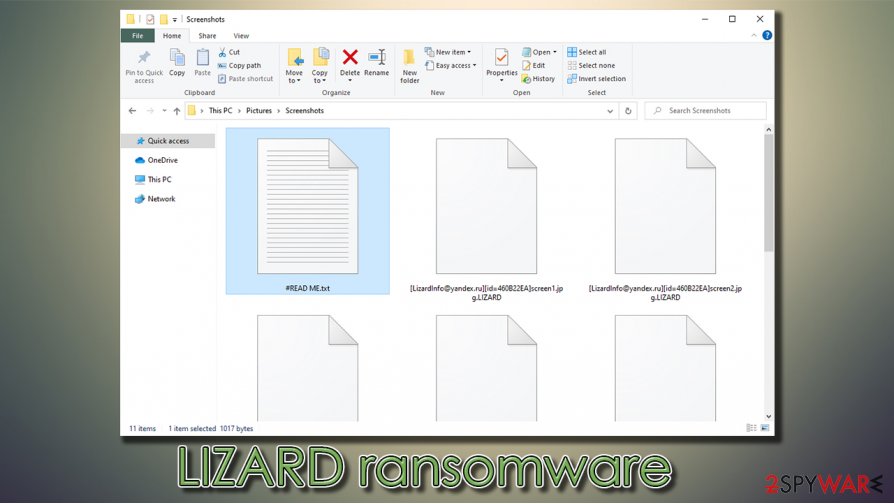LIZARD ransomware (Virus Removal Guide) - Free Instructions
LIZARD virus Removal Guide
What is LIZARD ransomware?
LIZARD ransomware – cyber infection that might result in complete data compromise

LIZARD ransomware is a malicious program that attacks Windows computers by locking all non-system files, such as pictures, videos, music, documents, etc. Malware, which belongs to Flamingo virus family, uses sophisticated encryption tactics by utilizing both AES and RSA[1] algorithms, which also appends each of the files with .LIZARD extension, as well as additional stings, containing the user ID and the contact email. Suchlike files lose distinctive icons and become fully inaccessible.
While the .LIZARD files are unavailable, it does not mean that they are corrupted. It becomes apparent as soon as malware delivers a ransom note #READ ME.TXT – the attackers demand payment in Bitcoin in order to recover a unique decryption software which, once used, could unlock all the files on the computer.
But before that, victims are asked to send threat actors their personal ID and a test file for decryption via the LizardInfo@yandex.ru or LizardSup@tutanota.com emails. Nonetheless, we do not recommend contacting the attackers because they might not deliver the required decryption tool. Check out the alternative methods we provide below instead and take care of LIZARD ransomware removal first.
| Name | LIZARD ransomware |
|---|---|
| Type | Ransomware, data locking malware, cryptovirus |
| Malware family | Lizard ransomware |
| Encryption method | A combination of RSA and AES is used to lock all non-system and non-executable files on the host machine |
| File extension | Malware uses a three-part extension, which consists of a contact email, user ID (appended before the file name), and a .LIZARD extension. Example of an encrypted file: [LizardInfo@yandex.ru][id=460B22EA]picture.jpg.LIZARD |
| Ransom note | #READ ME.TXT |
| Contact | LizardInfo@yandex.ru or LizardSup@tutanota.com |
| File Recovery | If no backups are available, recovering data is almost impossible. Nonetheless, we suggest you try the alternative methods that could help you in some cases – we list them below |
| Malware removal | Perform a full system scan with powerful security software, such as SpyHunter 5Combo Cleaner |
| System fix | Malware can seriously tamper with Windows systems, causing errors, crashes, lag, and other stability issues after it is terminated. To remediate the OS and avoid its reinstallation, we recommend scanning it with the FortectIntego repair tool |
Flamingo ransomware, which is a relatively new strain, first showed up in September 2020. This is the first version which uses .LIZARD extension. While it is yet unknown which actors are behind the strain, it seems like they are determined to keep going, as already four versions have been released within just a couple of months. It is not surprising since the ransomware business is extremely lucrative,[2] and many criminals are keen to grab some cash.
As soon as the LIZARD virus gains access to a Windows machine, it begins changing the way it operates. One of the main goals of the threat is to ensure that the file encryption process is successful, so it immediately attempts to break into Windows defenses and delete Shadow Copies. The virus also drops several hundred malicious files on the system and changes the Windows registry, as well as several other sectors.
While malicious files can be deleted during LIZARD ransomware removal, some system damage sustained during the attack could remain. Hence, security experts[3] recommend using FortectIntego or another repair tool that might return your Windows back to normal without having to reinstall it.

As soon as malware finishes with the system changes, it begins the encryption process. Most viruses of such type simply append a standalone extension or add additional components to each of the files. However, this malware uses a little bit different method – it appends the user ID and the email before the file name, followed by .LIZARD extension.
Data encryption process only lasts a moment, and a ransom note is delivered soon after, which reads:
———-[ All your data is encrypted by a strong encryter L!zarD ]———-
=========================== # Unique ID : 460B22EA
=========================== # E-mail : LizardInfo@yandex.ru================================================================================
” PLEASE BE CAREFUL ” :
if your data is important to you, And you want to make a payment, be sure
to send us a test file first(3 Mb),And make sure we have the ability to
open your files(Decrypt test files).So first send the test file to prove
that we can decrypt your files, Then make a payment (Buy BTC) and receive the
decryption tool (Send Decrypter).
================================================================================
If you do not receive a reply after sending us an email,
please send an email to the second email address.
second E-mail : LizardSup@tutanota.com
================================================================================
As evident, the attackers want to make victims trust them, as they offer free test decryption solution. However, we recommend you do not trust hackers, as they might take your money and never deliver the decryption tool. Instead, remove LIZARD ransomware with SpyHunter 5Combo Cleaner, Malwarebytes, or another reputable security software and attempt to recover data in different ways – we provide a few solutions below.
Ransomware distribution methods: learn to protect yourself
Many users who get infected with ransomware are quite shocked. This is because most ransomware victims never encountered such an infection before. This also makes many believe that they can recover .LIZARD files as soon as they scan their computers with anti-malware. Unfortunately, that is far from the truth, as crypto-malware after-effects remain present even after the virus is deleted. In other words, you won't get your files back just because you remove the infection from your computer (although this is a necessary procedure regardless). If no backups are available, data recovery possibilities are very limited, unfortunately.
Therefore, it is best to avoid ransomware infiltration in the first place – here are some tips that you should take into consideration each time you turn on a PC connected to the internet:
- Install powerful anti-malware software and keep it updated;
- Never download software cracks or pirated program installers;
- Do not allow documents attached to unknown emails to run macros on your system (“Allow Content” feature);
- Update your operating system and all the installed software regularly;
- Use secure and complex passwords for all your accounts and never leave your WiFi opened to everyone;
- Backup your most important files on a regular basis – this is the easiest way to recover from a ransomware attack.
Get rid of LIZARD virus and only then proceed with data recovery
If you have no backups available, it is important you do not proceed with LIZARD ransomware removal immediately. First, you have to make sure you copy all of your most important encrypted files to a separate medium (locked data does not hold any malicious code, so it is safe to move); otherwise, the files might be permanently damaged by security software. This is also useful if you later decide to pay the ransom after all – keep in mind it is an absolute last resort, and the risk of losing your money prevails!

As soon as that is done, remove LIZARD ransomware with powerful anti-malware software, such as SpyHunter 5Combo Cleaner or Malwarebytes. If, for some reason, your security software is struggling to work due to the presence of malware, access Safe Mode with networking as explained below and perform the scan from there. Also, use FortectIntego to remediate Windows system files, as you might face crashes, errors, or other stability issues otherwise. Finally, follow the data recovery instructions below.
Getting rid of LIZARD virus. Follow these steps
Manual removal using Safe Mode
You can access Safe Mode with Networking if you can not delete the virus in a normal mode:
Important! →
Manual removal guide might be too complicated for regular computer users. It requires advanced IT knowledge to be performed correctly (if vital system files are removed or damaged, it might result in full Windows compromise), and it also might take hours to complete. Therefore, we highly advise using the automatic method provided above instead.
Step 1. Access Safe Mode with Networking
Manual malware removal should be best performed in the Safe Mode environment.
Windows 7 / Vista / XP
- Click Start > Shutdown > Restart > OK.
- When your computer becomes active, start pressing F8 button (if that does not work, try F2, F12, Del, etc. – it all depends on your motherboard model) multiple times until you see the Advanced Boot Options window.
- Select Safe Mode with Networking from the list.

Windows 10 / Windows 8
- Right-click on Start button and select Settings.

- Scroll down to pick Update & Security.

- On the left side of the window, pick Recovery.
- Now scroll down to find Advanced Startup section.
- Click Restart now.

- Select Troubleshoot.

- Go to Advanced options.

- Select Startup Settings.

- Press Restart.
- Now press 5 or click 5) Enable Safe Mode with Networking.

Step 2. Shut down suspicious processes
Windows Task Manager is a useful tool that shows all the processes running in the background. If malware is running a process, you need to shut it down:
- Press Ctrl + Shift + Esc on your keyboard to open Windows Task Manager.
- Click on More details.

- Scroll down to Background processes section, and look for anything suspicious.
- Right-click and select Open file location.

- Go back to the process, right-click and pick End Task.

- Delete the contents of the malicious folder.
Step 3. Check program Startup
- Press Ctrl + Shift + Esc on your keyboard to open Windows Task Manager.
- Go to Startup tab.
- Right-click on the suspicious program and pick Disable.

Step 4. Delete virus files
Malware-related files can be found in various places within your computer. Here are instructions that could help you find them:
- Type in Disk Cleanup in Windows search and press Enter.

- Select the drive you want to clean (C: is your main drive by default and is likely to be the one that has malicious files in).
- Scroll through the Files to delete list and select the following:
Temporary Internet Files
Downloads
Recycle Bin
Temporary files - Pick Clean up system files.

- You can also look for other malicious files hidden in the following folders (type these entries in Windows Search and press Enter):
%AppData%
%LocalAppData%
%ProgramData%
%WinDir%
After you are finished, reboot the PC in normal mode.
Remove LIZARD using System Restore
System Restore could sometimes be useful when trying to eliminate the infection:
-
Step 1: Reboot your computer to Safe Mode with Command Prompt
Windows 7 / Vista / XP- Click Start → Shutdown → Restart → OK.
- When your computer becomes active, start pressing F8 multiple times until you see the Advanced Boot Options window.
-
Select Command Prompt from the list

Windows 10 / Windows 8- Press the Power button at the Windows login screen. Now press and hold Shift, which is on your keyboard, and click Restart..
- Now select Troubleshoot → Advanced options → Startup Settings and finally press Restart.
-
Once your computer becomes active, select Enable Safe Mode with Command Prompt in Startup Settings window.

-
Step 2: Restore your system files and settings
-
Once the Command Prompt window shows up, enter cd restore and click Enter.

-
Now type rstrui.exe and press Enter again..

-
When a new window shows up, click Next and select your restore point that is prior the infiltration of LIZARD. After doing that, click Next.


-
Now click Yes to start system restore.

-
Once the Command Prompt window shows up, enter cd restore and click Enter.
Bonus: Recover your data
Guide which is presented above is supposed to help you remove LIZARD from your computer. To recover your encrypted files, we recommend using a detailed guide prepared by 2-spyware.com security experts.If your files are encrypted by LIZARD, you can use several methods to restore them:
Data Recovery Pro could help you with your files
This tool might be able to retrieve at least some files from within your hard drive.
- Download Data Recovery Pro;
- Follow the steps of Data Recovery Setup and install the program on your computer;
- Launch it and scan your computer for files encrypted by LIZARD ransomware;
- Restore them.
Windows Previous Versions feature could be your choice when trying to recover .LIZARD files
If malware didn't delete automatic Windows backups, you should be able to use Windows Previous Versions feature to retrieve files one-by-one.
- Find an encrypted file you need to restore and right-click on it;
- Select “Properties” and go to “Previous versions” tab;
- Here, check each of available copies of the file in “Folder versions”. You should select the version you want to recover and click “Restore”.
ShadowExplorer is here to help
Just as with the previous method, ShadowExplorer would only work if Lizard ransomware failed to delete Shadow Copies from your system.
- Download Shadow Explorer (http://shadowexplorer.com/);
- Follow a Shadow Explorer Setup Wizard and install this application on your computer;
- Launch the program and go through the drop down menu on the top left corner to select the disk of your encrypted data. Check what folders are there;
- Right-click on the folder you want to restore and select “Export”. You can also select where you want it to be stored.
No decryptor is currently available
Finally, you should always think about the protection of crypto-ransomwares. In order to protect your computer from LIZARD and other ransomwares, use a reputable anti-spyware, such as FortectIntego, SpyHunter 5Combo Cleaner or Malwarebytes
How to prevent from getting ransomware
Access your website securely from any location
When you work on the domain, site, blog, or different project that requires constant management, content creation, or coding, you may need to connect to the server and content management service more often. The best solution for creating a tighter network could be a dedicated/fixed IP address.
If you make your IP address static and set to your device, you can connect to the CMS from any location and do not create any additional issues for the server or network manager that needs to monitor connections and activities. VPN software providers like Private Internet Access can help you with such settings and offer the option to control the online reputation and manage projects easily from any part of the world.
Recover files after data-affecting malware attacks
While much of the data can be accidentally deleted due to various reasons, malware is one of the main culprits that can cause loss of pictures, documents, videos, and other important files. More serious malware infections lead to significant data loss when your documents, system files, and images get encrypted. In particular, ransomware is is a type of malware that focuses on such functions, so your files become useless without an ability to access them.
Even though there is little to no possibility to recover after file-locking threats, some applications have features for data recovery in the system. In some cases, Data Recovery Pro can also help to recover at least some portion of your data after data-locking virus infection or general cyber infection.
- ^ Ron Franklin. AES vs. RSA Encryption: What Are the Differences?. Precisely. Data accuracy.
- ^ Filip Truta. Why Ransomware Continues to Be an Immensely Profitable Business for Bad Actors. Bitdefender. Security blog.
- ^ Senzavirus. Senzavirus. Cybersecurity advice and malware insights.







